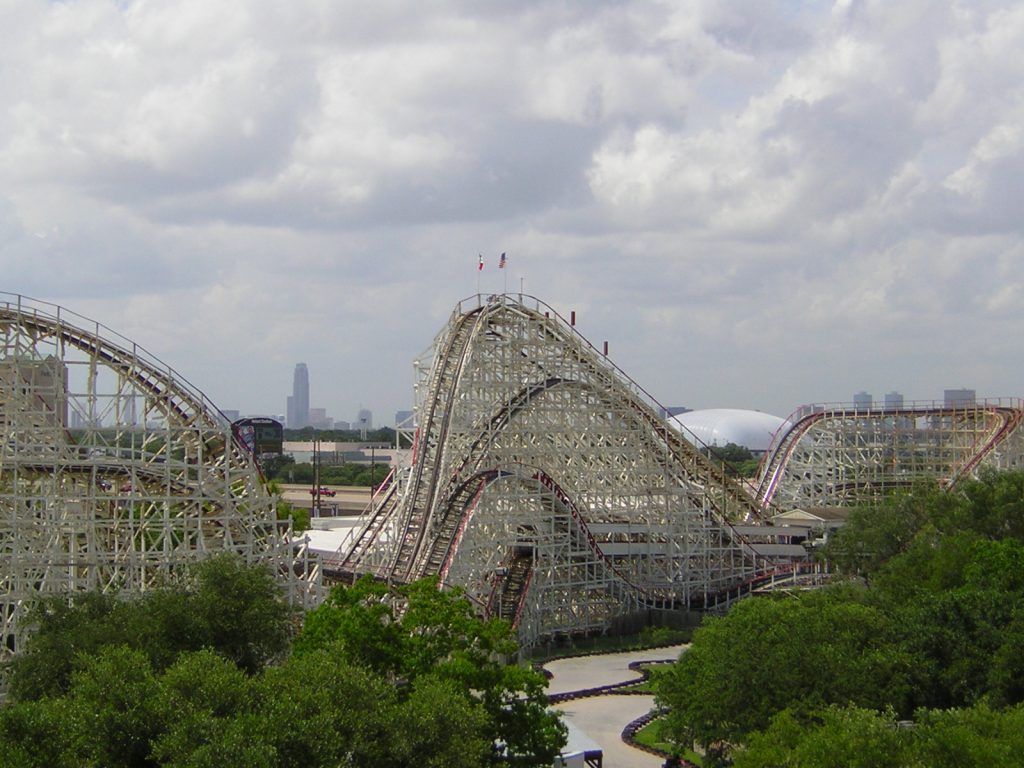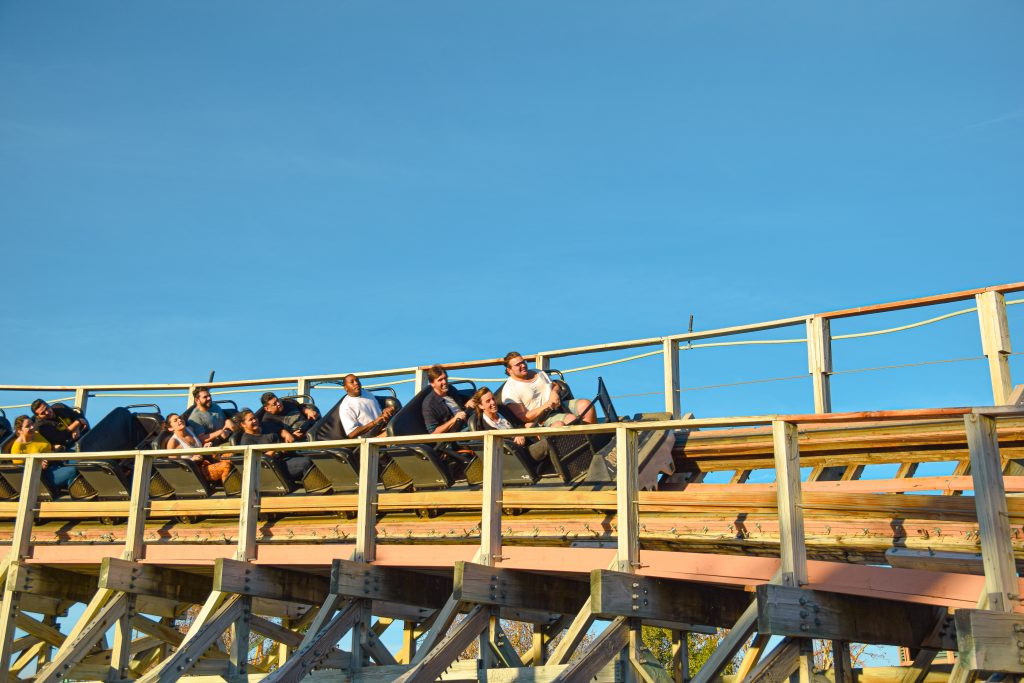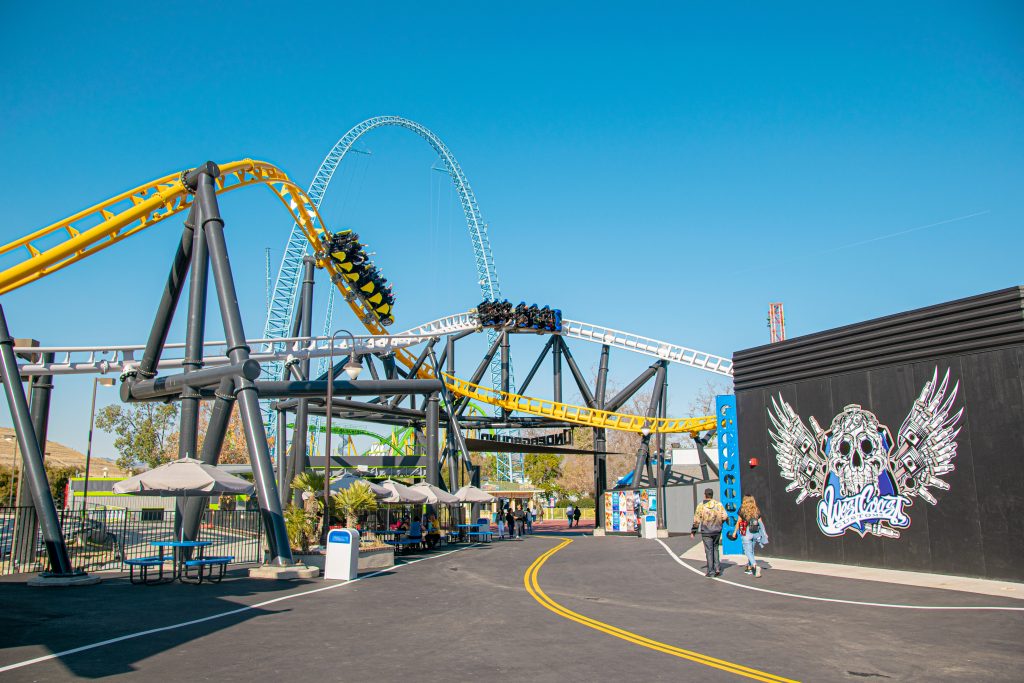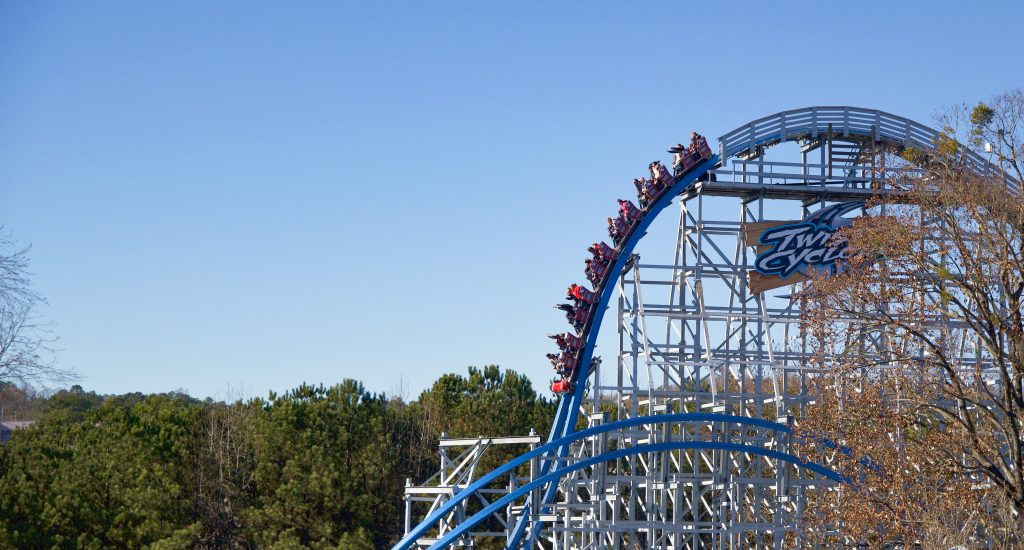In Part 4 we looked at the construction and eventual transformation of California’s tallest wooden coaster, Colossus. Today’s lost coaster resided at the same park. This story includes a natural disaster, a young Swiss ride manufacturer, and the unfortunate death of a coaster design icon.
– In the past, many of our images have been posted, featured, and shared on forums, social media platforms and websites around the web. We work hard to provide the coverage that we do, and we encourage our audience to share our content and use our images, BUT ONLY IF proper credit is given to thecoasterkings.com. Thank you! –
This article aligns with a special podcast mini-episode! Click the logo below to listen to the podcast!

As discussed last week, Kings Island’s Racer proved the marketability of large scale thrill-coasters. In 1976 Houston’s Six Flags Astroworld unveiled their large scale wooden coaster, Texas Cyclone. Initially the park sought to relocate the famous Coney Island Cyclone to Texas. This proved financially impractical and Six Flags turned to William Cobb who designed a taller and faster mirrored version of Cyclone. Texas Cyclone became a big hit and proved to be the first of many coasters which borrowed Cyclone’s famous layout. Six Flags returned to the concept in 1990 hiring Curtis D. Summers and Charles Dinn of the Dinn corporation to build a Cyclone clone at Six Flags Over Georgia. Following Georgia Cyclone’s debut Six Flags would ask Dinn to build another Cyclone clone at Magic Mountain for the 1991 season.

In 1977 Magic Mountain unveiled a permanent crafts-village called Spillikin Corners. This corner of the park consisted of 19th century style wild-west buildings which showcased different types of handicraft. It also provided a destination for the park’s Grand Centennial Excursion train which previously had passed by a herd of buffalo(that’s right, real buffalo at Magic Mountain). This area proved successful but it was difficult to leave this prime real estate void of any thrill rides. In 1984 Six Flags opened the Sarajevo Bobsleds, and Intamin Bobsled coaster that only lasted to 1985 when is was relocates to Six Flags over Texas and eventually renamed La Vibora. The Sarajevo Bobsleds‘ 1986 replacement was Shockwave, a groundbreaking stand up roller coaster by Swiss manufacturer Intamin. Six Flags built Shockwave as part of their ride rotation program. It spent two years at Magic Mountain before a relocation to Great Adventure. This left an empty plot of land at the back of the park. In 1991 a loose nautical theme was applied to the rustic buildings and the area was re-christened Cyclone Bay in honor of its new star attraction, Psyclone.
Six Flags marketed Psyclone as the “Ultimate Mindbender,’ a twisted compact counterpart to the sprawling Colossus. Problems plagued Psyclone as soon as it opened. After many rider complaints of excessive discomfort, Six Flags had to reprofile Psyclone and its Georgia sibling after their opening years. It didn’t help that Psyclone featured trains by Swiss company Bolliger and Mabillard which had just split from Intamin/Gionavola a year prior. The B&M trains were much heavier than typical wooden coaster trains and took their toll on the ride’s track and structure. Citing their problems with both of the Dinn Cyclone clones, Six Flags sued and won a $1.78 million civil judgment against Curtis Summers and received a $125,000 settlement with the now-bankrupt Dinn Corporation. On May 11, 1992, in the midst of this legal battle, Curtis Summers died of a heart attack at 62 years old. Summers had helped design over twenty roller coasters including assisting the famous John Allen in the designs for Kings Island’s Racer. His death marked the end of another era of wooden coaster design.

The death of its designer did not spell the end for Psyclone’s woes. The 1994 Northridge earthquake caused structural damage on Psyclone requiring significant modifications to the structure and the way the ride operated. Never an especially fast-paced attraction, Psyclone was slowed down even more by braking and reprofiling. Eventually the park required ride operators to have at least seventeen passengers in each train to ensure the train was able to complete the course. Enthusiasts began accusing Psyclone of two deadly sins, it was rough and it was boring. Its reputation continued to decline and, like Colossus, even the addition of a flashy new coaster nearby, 2001’s Deja Vu, didn’t help it’s dwindling ridership. Six Flags announced Psyclone’s removal in January of 2007 and its demolition began soon after.

In 2009 Magic Mountain would receive another “next generation” wooden coaster built by Great Coaster International. Themed to the eponymous movie franchise, Terminator Salvation: The Ride, eventually renamed Apocalypse the Ride, opened to much better reviews than the Dinn woodie that previously occupied its plot. The Cyclone bay area remained, losing Deja Vu in 2011 but retaining structures that dated back to Spillikin Corners. In 2019 Six Flags announced it’s transformation to the street-racing themed Underground, removing the final reference to Psyclone more than 10 years after its demolition. After significant construction delays West Coaster Racers opened alongside The Underground in January of 2020. This Premier Rides multi-launch coaster breathed new life into the back corner of Magic Mountain. Psyclone’s Dinn siblings did not fare much better. Of the ten coasters constructed by the Dinn Corporation only four remain operational. Rocky Mountain Construction has converted three into hybrid coasters. The remaining three, including Psyclone, have been relegated to history.

Have you had the opportunity to ride one of the remaining Dinn coasters? What do you think of Psyclone’s infamous reputation? Next week we will be looking at another infamously uncomfortable ride which began it’s life at California Great America’s sister park in Illinois. Join me as we take a look at the first and only Intamin “space diver,” Flashback.



Psyclone was a rough ride. I rode Psyclone at Magic Mountain at least 10 times. In fact, the first time I rode it was on a dare from my dad. He gave me sister and I EACH $100 if we ride BOTH Viper and Psyclone. We didn’t get anything if we only rode one. We had to ride both. We did it. Psyclone was so rough, it knocked my earring out of my ear. But with that $100, I bought a duel cassette tape player and a boogie board…. It was the ’90’s.
Wow! I’m saddened to read about Psyclone’s reputation. It was over of my favorite rides. I rode it every time I visited the park until it closed.